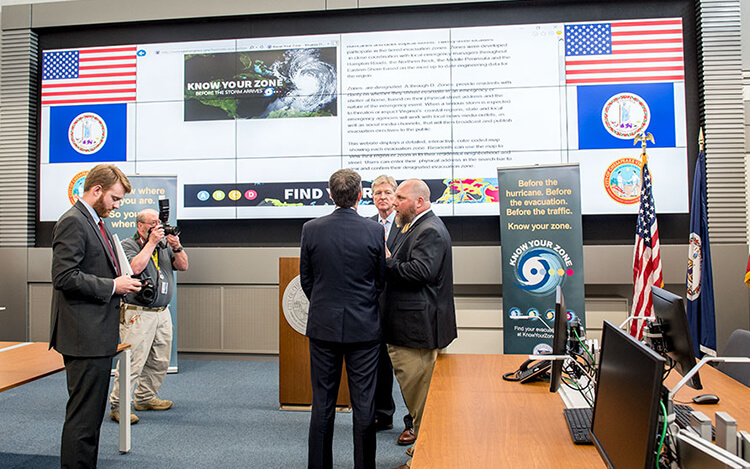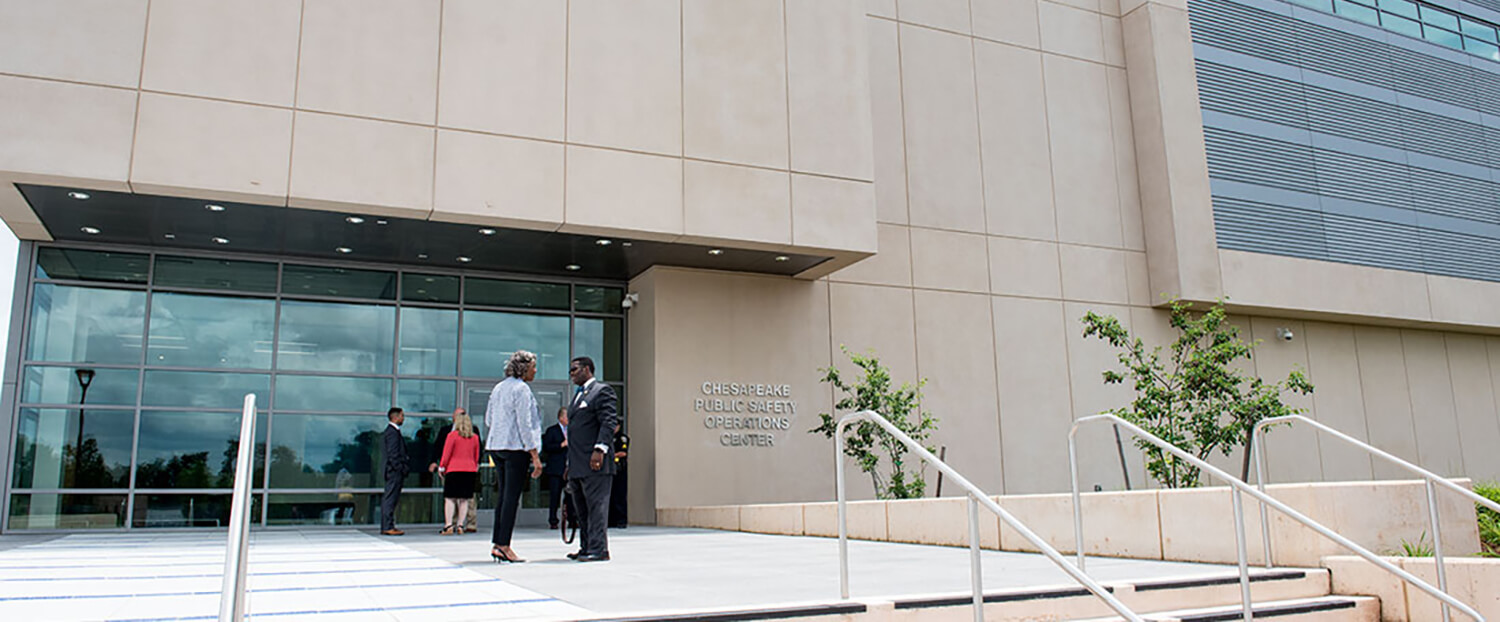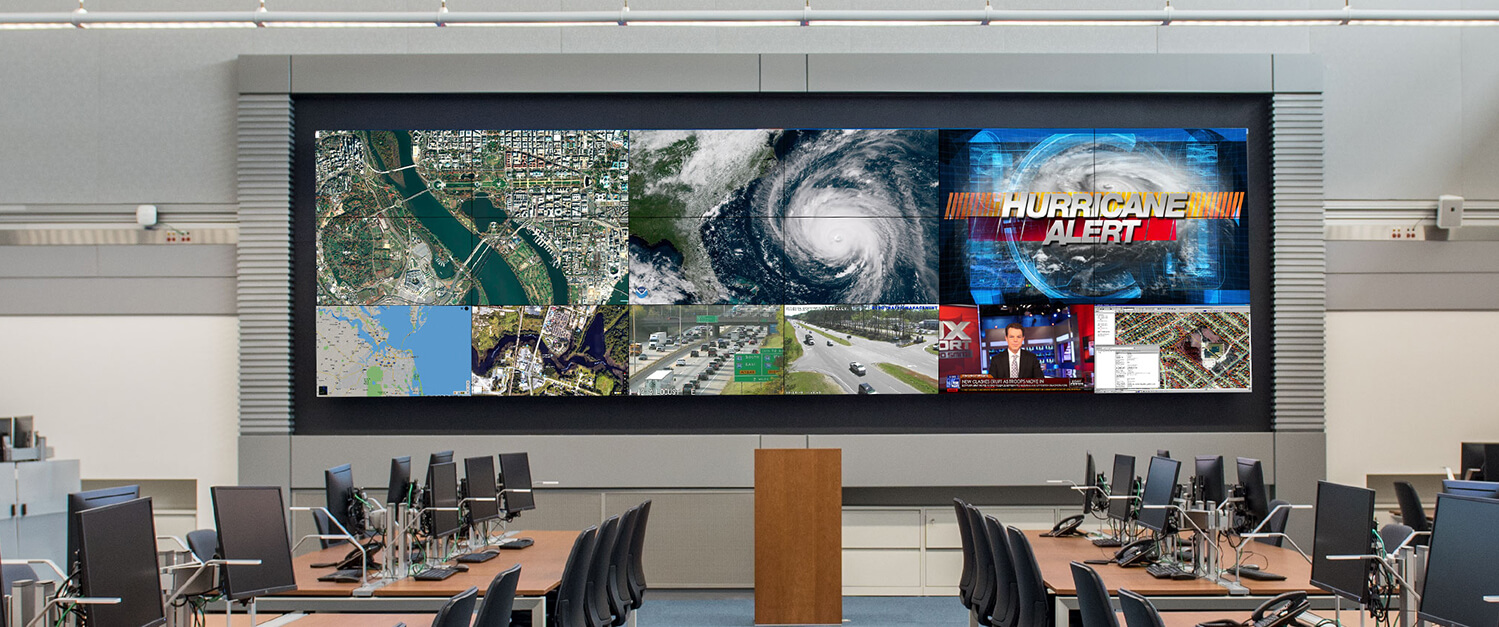How the Haivision Video Wall Solution Drives Efficiency and Resiliency for the City of Chesapeake’s Public Safety Departments
At 350 square miles, the City of Chesapeake is the second-largest city by land mass in the Commonwealth of Virginia and one of the largest cities in the United States. While Chesapeake has only 233,000 residents, the city’s emergency management department is tasked with responding to any major weather events affecting the greater Hampton Roads harbor region, which has a population of 1.8 million.
Due to the area’s low elevation and proximity to the coast, Hampton Roads is particularly susceptible to hurricanes, flooding, nor’easters, and other natural disasters. As a result, the City of Chesapeake is responsible for monitoring a vast stretch of land and sea for public safety events throughout the year.
Robb Braidwood
Deputy Coordinator of Emergency Management, City of Chesapeake


The City of Chesapeake’s public safety departments and other critical city services were spread out across multiple locations with little-to-no data interconnectivity. Compounding this issue, the city’s wireless capabilities were restricted due to interference from nearby Federal agency offices and military outposts. Without an effective way to aggregate and share critical information for such a large area, interdepartmental communication was slow and inefficient.
During emergency activations, City of Chesapeake employees converted a 900-square-foot meeting room in the municipal center headquarters into a makeshift Emergency Operations Center (EOC). In addition to having limited seating and computers, this facility was in Flood Zone A—the first area evacuated during major weather events.
For nearly a decade, local public safety leadership and city officials explored possible strategies to consolidate the City of Chesapeake’s emergency services operations and improve situational awareness. Research teams from Chesapeake visited EOC sites across the country and consulted with a number of architects, engineers, and emergency management experts to determine a solution that would address the city’s unique environmental and technological needs.
In April 2015, the City of Chesapeake broke ground on a three-story, 51,000-square-foot Public Safety Operations Center (PSOC) to house critical city operations including a dedicated EOC, a 911 Emergency Call Center (ECC), a 311 Non-Emergency Call Center, and Fire and Police Training Administration spaces. With construction underway, city officials and other key stakeholders began researching vendors for the facility’s video wall solution.
Unlike many PSOCs, the City of Chesapeake’s facility required multiple video walls and auxiliary displays that could route data to different rooms across the building. In particular, the search committee wanted a vendor that would address two key needs:
After a month’s-long search, Haivision was selected to create a robust, turn-key visualization system for the entire PSOC.

Completed in December 2017, Chesapeake’s $40.2-million, state-of-the-art PSOC was purpose-built for resilience and efficiency. The building was designed with a multitude of safety features, including a category-3 hurricane structure, impact-resistant glass, a renewable water supply, and a cafeteria stocked to feed and house emergency responders for at least two weeks.
The first of its kind in terms of scale and digital interconnectivity, the next-generation public safety facility comprises of more than 100 networked displays connected by two Alpha FX Core processor running Haivision’s video wall management software across the building.
The facility also includes extensive redundancies to preserve operability, including redundant video wall and mechanical systems, a backup Network Operations Center (NOC), two emergency generators, and an on-site cell phone tower.
The City of Chesapeake’s new EOC is a two-story, 3,600-square-foot room built to accommodate up to 100 people. At the front of the room, a bright, LCD video wall displays an interactive dashboard of live camera feeds, weather data, news programs, and real-time tracking tools. The EOC also contains seven 55” auxiliary displays mounted throughout the room. To meet the EOC’s need for 24/7 reliability, each display was designed with redundant power supplies.
To route signals to the EOC’s video wall and auxiliary screens, Haivision Installed an Alpha FX Core processor. The Core processor accepts data in virtually any format, allowing end users to display multiple content sources simultaneously and dynamically arrange information.<?p>
During an EOC activation, three emergency management supervisors sit directly in front of the video wall, controlling the content displayed on the screens behind them. Sitting across from management are 50-75 employees monitoring information on either the video wall or personal observation devices (PODs) from 14 separate team workstations. These teams use Haivision’s user-friendly video wall software, to rapidly gather intelligence, share critical insights, and coordinate strategic responses to everything from road closures to evacuation orders.
The City of Chesapeake’s 911 Emergency Call Center (ECC) features a bright LCD video wall connected via an Alpha FX Core processor. In the front of the room, the ECC’s video wall displays an arrangement of surveillance footage and digital tools, including television programs, license plate scanners, a Computer-Aided Dispatch (CAD) call-mapping system, and the Live Earth geo-mapping platform that uses real-time data from emergency calls and surveillance applications to generate a live, 3D map of the city.
Sitting in front of the video wall, the ECC shift commander and supervisors control the content shown on-screen behind them. They are faced by a team of dispatchers at 20 individual workstations.
When a call requires a response unit, dispatchers use data displayed on the video wall to provide critical, real-time updates to first responders and monitor the situation as it develops. When a situation requires a specific tool or content source, supervisors use Haivision software to quickly rearrange the content sources into one of several pre-arranged custom layouts.
Located on the third story of the PSOC, the City of Chesapeake’s 311 Non-Emergency Call Center is equipped with two wall-mounted 55” LCDs. Using the Alpha FX Core processor, operators can switch content sources on the video wall to display television broadcasts, data from their own devices (“BYOD”), or content from the EOC and ECC. This flexibility enables operators to identify patterns and prioritize service requests for non-emergency issues such as road damage.<?p>
When the EOC is activated, 311 dispatchers use their auxiliary displays to help contextualize data, coordinate responses with other departments, and keep callers informed.
The PSOC’s first-floor Media Briefing Room includes six rows of audience seats facing a podium next to two 75” high-definition displays. When city officials host press conferences or meet with media representatives, Haivision technology enables them to feed content from the EOC, the ECC, or their own devices directly to the display wall. This enables audience members to visualize key information while they listen to the speaker.
In addition to the large operations and call centers, the City of Chesapeake PSOC houses 31 huddle rooms, training rooms, conference rooms, and joint operations facilities with a range of 55” and 70” networked displays linked across the building via video wall software. Each display has BYOD connectivity, and CineLink HD encoders and decoders provide a scalable AV/IP platform that allows end users to send content anywhere in the building, from any device.

The PSOC and its Haivision video wall solution have revolutionized the way the City of Chesapeake prepares for and responds to public safety events:
In September 2018, at the peak of Hurricane Florence, the City of Chesapeake was expected to take a direct hit. Public safety leadership activated the EOC for the first time, leveraging Haivision’s interactive dashboards to track the storm in real-time, coordinate emergency incident responses, and determine which zones needed to be evacuated.
“For us, the two critical systems we need are the Internet and Haivision. Because for us, the lifeblood of an emergency operations center is collaboration,” says Robb Braidwood, Deputy Coordinator of Emergency Management.
The City of Chesapeake’s Haivision video wall system not only facilitates daily interdepartmental collaboration and increased situational awareness, but also enables public safety teams to make faster, more informed decisions as they work to protect and serve the Hampton Roads region’s 1.8 million residents.
The Virginian – Pilot, Chesapeake Public Safety Operations Center opens
Clark Nexsen, Chesapeake Public Safety Operations Center Project Overview